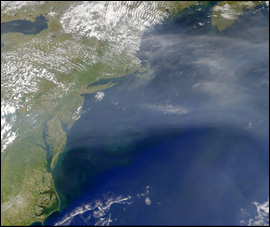
Aerosol Chemistry & Microphysics
Two-Column Aerosol Project (TCAP)
There remain many key knowledge gaps despite advances in the scientific understanding of how aerosols and clouds evolve and affect climate. Many climatically important processes depend on particles that undergo continuous changes within a size range spanning a few nanometers to a few microns, and with compositions that consist of a variety of carbonaceous materials, soluble inorganic salts and acids and insoluble mineral dust. Primary particles, which are externally-mixed when emitted, are subject to coagulation and chemical changes associated with the condensation of semi-volatile gases to their surface resulting in a spectrum of compositions or mixing-states with a range of climate-affecting optical and hygroscopic properties. The numerical treatments of aerosol transformation and cloud-aerosol interactions are highly simplified in large-scale models, contributing to the uncertainties associated with aerosol direct and indirect forcing in climate models used to determine safe levels of greenhouse gases for the Earth system.
The Two-Column Aerosol Project (TCAP) is designed to provide a detailed set of observations with which to 1) perform radiative and cloud condensation nuclei (CCN) closure studies, 2) evaluate a new retrieval algorithm for aerosol optical depth (AOD) in the presence of clouds using passive remote sensing, 3) extend a previously developed technique to investigate aerosol indirect effects, and 4) evaluate the performance of a detailed regional-scale model and a more parameterized global-scale model in simulating particle activation and AOD associated with the aging of anthropogenic aerosols.
To meet these science objectives, the Atmospheric Radiation Measurement (ARM) Climate Research Facility will deploy the ARM Mobile Facility and the Mobile Aerosol Observing System on Cape Cod, Massachusetts, for a 12-month period starting in the summer of 2012 in order to quantify aerosol properties, radiation, and cloud characteristics at a location subject to both clear and cloudy conditions, and clean and polluted conditions. These observations will be supplemented by two aircraft intensive observation periods, one in the summer and a second in the winter.





